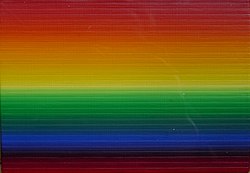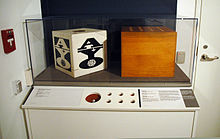Ay-O
Takao Iijima (born May 19, 1931), better known by his art name Ay-O (靉嘔 Ai Ō),[1] is a Japanese avant-garde visual and performance artist who has been associated with Fluxus since its international beginnings in the 1960s.
Another independent movement was close to Demokrato in Japan: Sōzō Biiku (創造美育) by the collector Sadajirō Kubo (久保貞次郞)promoting nurturing freedom when teaching art.
Both movements started in Fukui Prefecture in Japan and explain the special bond Ay-O developed with the place.
In 1955, Ay-O founded a group called Jitsuzonsha ("The Existentialists") along with printmaker and writer Masuo Ikeda, artist Hiroshi Manabe, and others.
He worked closely with fellow Fluxus artists Maciunas, Emmett Williams, Dick Higgins, and Nam June Paik.
[2] In 1971, true to his Demokato debut, he adapted 10 American Naïve paintings and created a rainbow version that he called Nashville Skyline.
In 2001 Ay-O had a room in the special exhibit "La fluxus Constellation" in the Museum of Contemporary Art in Genoa.
Finally in 2012 the MUSEUM OF CONTEMPORARY ART TOKYO (MOT) showed a large retrospective exhibition: "Over the Rainbow once more.
In 2012 the MOMA produced an exhibit titled : Tokyo 1955-1970 Avant Garde where Ay-O's work in that period are presented.
In 2012 similar retrospective augmented by recent works "Ay-O: Over the Rainbow Once More" is shown in various locations in Japan (e.g., [20]) - the inaugural exhibit was in the Tokyo MOT [21][22].
From December 2023 to May 2024, M+ in Hong Kong hosted a monographic exhibition of Ay-O, featuring oil paintings, sculptures, and prints spanning from the 1950s to the 2000s.
[8] The artworks comprise largely identical hollow cubical wooden boxes with finger-sized holes in one face.
As tactile works of art, it is necessary to touch them to perceive them, by placing one's finger into the hole to feel the material that is hidden within the box.
The hidden contents of the boxes comprise such various things as beads, bristle brushes, hair, cotton balls, nails, and sponges.
The finger boxes are also intended to be touched by multiple people at a time, promoting a shared, social, experience of perceiving the work.
True to his Japanese beginning and the Democrato movement Ay-O took some special care to produce print version of his work.
In a way similar to the execution of the Nashville Skyline (where the color was applied by others), Ay-O use number coding to communicate with his printers, 12 is lemon yellow, 1 red, 24 purple.
Sometimes the Kappa persona appears in works like in these 'fluxus masks' where Ay-o by the simple application of his rainbow palette assimilates a traditional Aztec face into contemporary art.
Those Aztec faces in spite of his fierce independence (or maybe through it) mark Ay-o's allegiance to the wider fluxus movement [36][37].
With arrival of the rainbow period in the 1980s some new signature is introduced where the O encircles the other letter in a cartouche-like manner like in this example of 1985 on one of the large 96 gradations work.


